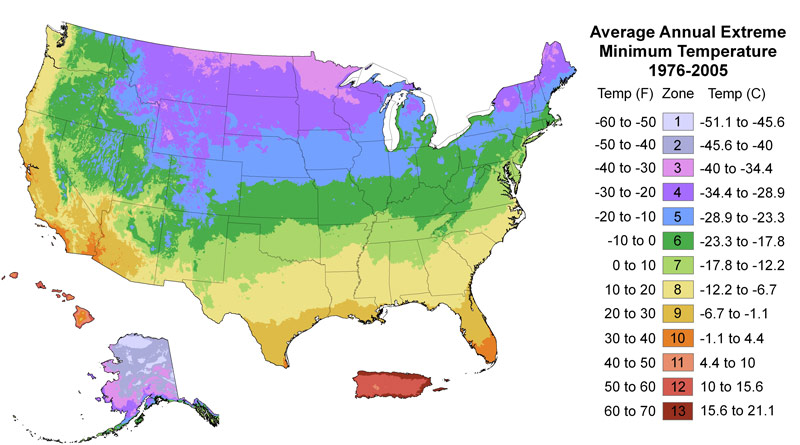Eureka Lemon Tree
Eureka Lemon trees produce the typical grocery store lemon. They are tart, high in vitamin C, and have a wide variety of uses in cooking and beyond.
Not compatible with your zone (2a)
General Plant Information
The Eureka Lemon Tree is a small evergreen tree that produces the classic, football-shaped, tart fruits that we are accustomed to buying at the grocery store and using in recipes. Eureka lemon trees grow vigorously and produce heavy crops of fruits all year round.
The Eureka lemon was introduced to Los Angeles in 1958, from seeds that originated in Italy. But the lemon tree’s history goes back thousands of years.
The lemon tree is thought to have originated in Myanmar (Burma) or Assam, India. From there, it made its way through Persia, to the Middle East, and then onto the Mediterranean. It was introduced to the Americas by Columbus in 1492 and then spread further through the Spanish Conquest.
Lemons have a long history of being used medicinally, symbolically, and for beauty purposes. The ancient Romans didn’t even use them in cooking, instead prizing them for decorative purposes and as a status symbol. Ancient Egyptians used lemon oil to embalm the dead. In the 1500s, Venetian women used a mixture of lemon juice and licorice bark to dye their hair blonde. The British Royal Navy used lemons to protect against scurvy. Lemon juice was even used to create invisible ink! As far back as 2000 years ago, the Greeks and Persians used this ink in espionage and to transmit wartime correspondences, a practice that continued in some form all the way up through WWII.
Today, lemon trees still have a dizzyingly wide variety of uses across culinary, household, medicinal, beauty, fragrance, landscaping, and decorative applications. Here are just a few:
Culinary
Lemons are used for their juice, zest, and pulp. They’re versatile when used with poultry, fish, and vegetable dishes, in soups, sauces, and marinades. Lemons are also used for preserving and pickling and can be used for meat tenderizing.
Delicious lemon-based options abound in baking: lemon bars, cakes, cookies, pies, and lemon curd.
In terms of beverages, we have our superstar, lemonade. Lemons are used in a wide variety of cocktails, for their juice and as a garnish. And there is also the Italian lemon liqueur, limoncello.
Try this recipe for lemon powder.
Cleaning & Household
Lemon juice can be used as a natural cleaner and disinfectant for surfaces, cutting boards, and kitchen utensils. It can also remove stains, freshen the air, and act as a natural deodorizer. Lemon peels can be used to make DIY citrus-infused cleaners, to get rid of ants, and can be placed in garbage disposals to freshen the scent.
Benefits
Lemons are high in vitamin C, bioflavonoids, and powerhouse antioxidants like polyphenols.
Many people enjoy drinking lemon water as a part of their morning routine.
Landscaping
Lemon trees have glossy green leaves and fragrant white blossoms, which add beauty and fragrance to gardens and landscapes. Their evergreen foliage provides shade and privacy, making them a popular choice for landscaping purposes.
Aromatherapy & Fragrance
Lemon oil is used in aromatherapy for its mood-boosting and invigorating properties. It also can ease anxiety. Lemon oil has antibacterial and antifungal properties
Eureka Lemon Tree Information and Care
Our Eureka Lemon tree is grown in Standard and Semi-Dwarf. The standard citrus tree has a single trunk with the canopy raised above the main trunk. The Semi-Dwarf grows like a bush with the canopy low to the ground. They are easier to pick than standard trees but need enough room to walk around them. These are also great for pots! Standard trees are often planted near a walkway since they can be walked under. Although a citrus tree can grow over 20 feet tall, prune to keep them short to desired height. Many grow their Eureka Lemon tree 9 – 15 feet tall. When it comes to spacing, plant citrus trees as close as 9-12 feet apart. Provide more space to allow for larger growth. A great choice for the home garden. Its small size will serve as a beautiful ornamental, as well as provide many fruits.
How To Plant, Water, and Fertilize Eureka Lemon Citrus Trees
Plant an Eureka Lemon tree in the full sun. Amend the soil with high-quality planting mix and fertilizer to improve the soil. Water a newly planted tree twice per week during the Spring through Summer. Water once per week in the Fall and Winter, while the weather is cool. Consequently, trees in hot climates or sandy soils may need water more frequently.
Spring is the most important time to fertilize a citrus tree. Use citrus food fertilizer with a 2-1-1 NPK ratio in the Spring through Summer. To promote growth, there is twice as much nitrogen to phosphorus and potassium. Blood meal and manure are great organic sources of nitrogen. Use a fertilizer with more phosphorus and potassium like bone meal during the Winter to promote flowers and fruit. Lemons are less attractive to birds and animals like squirrels.
Size and Spacing
Plant most citrus trees about 10 – 15 feet apart. Some varieties like Grapefruits and Oranges can grow larger.
Planning is the most important step when planting a tree. Plant your tree where it has enough space to grow to its full potential. Otherwise, your tree will grow into your surrounding trees. A tree that can grow taller with faster growth will overshadow nearby trees. You may need to move other trees to allow for the one that is thriving rather than cutting back one that naturally grows fast and tall.
Additional Information
Watering : RegularBloom Color : White
Sun Exposure : Full Sun
Plant Type: Evergreen
Pollination: Self-Fruitful / Self Pollinating
USDA Hardiness Zones: 8-11
Planting Information
Soil and Planting: Plant in soil that drains well. Dig a hole that is as deep as the tree’s roots and at least twice as wide.
Place the tree in the hole and backfill around the plant’s roots with a mixture of the native soil and high-quality planting mix that has washed sand and organic fertilizer.
Create a basin around the roots drip zone so that water collects. Water deeply until the roots and nearby soil is saturated and reaches field capacity.
Plant Care Information
Watering Basics
Irrigation Management Basics
Water Frequency – The frequency of water depends on seasonal weather conditions such as temperature, wind speed, and humidity, as well as factors like soil type and plant health. Sandy soils dry faster than clay soils.
In General
- Water newly planted trees 2 times per week during the Spring and Fall seasons.
- Increase the frequency when temperatures increase during the Summer
- Reduce frequency once temperatures drop in Winters
Quantity of Water – Provide enough water to saturate the soil around the tree’s roots, then drain to field capacity. Clay soils hold more water than sandy soils.
In General
- Give about 3 – 5 gallons of water for a 5-gallon size plant,
- 15 gallons of water for a #15-size container plant
- 25 gallons for a #25 depending on soil type.
Types Automatic Irrigation Systems – Help reduce operator error
Bubblers, sprinklers, and drips are the most common types of automatic irrigation systems. The duration a system is run depends on the emitter’s flow rate.
Fertilizer and Plant Nutrition
“NPK”
NITROGEN, PHOSPHORUS & POTASSIUM
NPK are the 3 macronutrients most used by plants and are represented numerically on the label. Apply this fertilizer with a higher ratio of Nitrogen to Phosphorus and Potassium in the Spring and Summer to promote plant growth. Use a fertilizer with a higher ratio of Phosphorus and Potassium to Nitrogen in the Winter or before plants flower to improve yields.
WHEN TO FERTILIZE
Use 8-4-4 every three months. Spring (March- April) through the fall
Use 3-12-12 Harvest Booster before plants flowering or during winter dormancy. (December – January)
HOW MUCH FERTILIZER
Apply 1 cup (150 grams) for every 1” diameter of the trunk or 15-gallon size Apply 2 cups (300 grams) for every 2” diameter of the trunk or 25-gallon size
HOW TO FERTILIZE
Instructions:
Winter Pruning and Summer Thinning
Prune your tree to allow light into its center for proper growth and fruit production.
Prune fruit trees in the Winter to maintain size and shape to prepare for Spring growth. Thin the tree in the Summer, and remove excessive fruits. Remove any dry twigs and branches. Cut off any new growth below the graft or very low in the tree, this will direct the plant’s energy to its main branches. Thin your trees during the Spring and Summer seasons to ensure the plant’s energy is directed as desired. Harvest ripe fruit to prevent undesired pests.
Harvesting and Pest Management
The basics of integrated pest management is cleanliness and the use of a combination of methods. This means we use of organic pesticide when the pest population reaches a threshold that requires action. Horticultural oils such as Neem oil is an organic pesticide that controls tiny, soft bodied insects. Use organic Bordeaux and Liqui-cop to manage fungus causing diseases such as powdery mildew, rust, and leaf-curls.
Keep a clean environment, free of weeds and dropped fruit that host insects or attract animals. Harvest when fruit reaches size and store indoors. Use repellants and bird netting to protect your harvest from other animals.
Sun Exposure: Full Sun
- Citrus trees require at least 5 hours of direct sunlight for proper growth and fruit production
- Afternoon Sunlight is more intense than the morning sun, therefore stress and damage can result if there is a lack of sufficient water.
- Lack of water combined with highly reflective surfaces like cinderblock walls, patios, fencing, etc can exasperate the breakdown of chlorophyll resulting in yellowing leaves. This is due to the building up of heat, and loss of water causing stomates in the leaf to close.
- Proper irrigation frequency and quantity, along with cooling of surrounding areas can assist in negating the effects of intense sunlight.
- Additionally, creating shade can assist in preventing tree damage caused by excessive sunlight and heat build-up
Limited Guarantee and Returns
Compatibility
The two factors that determine if a deciduous fruit trees will grow well and produce fruit in a certain area are the Chill Hour Requirement and the Cold Hardiness. “Chill hours” are the amount of cold a deciduous fruit tree need to produce fruit. This is measured in the number of hours below 45 degrees Fahrenheit a plant must experience during its winter dormancy. Paradise Nursery only grows Low Chill fruit trees that meet the chill requirements of all areas of the United States.
The second factor is Cold Hardiness. Cold Hardiness refers to the minimum temperature a plant can tolerate. The USDA’s Cold Hardiness Zones indicate the average minimum winter temperatures of areas. Based on the shipping zipcode, our website will only allow you to add plants to your cart that grow within your USDA Hardiness Zone, and tolerate your climate.
Pollination & Propagation
(Grafting/Cutting) Most of Paradise Nursery’s edible plants are self-fruitful. Self-pollinating trees do not require an additional tree to produce fruit. For your convenience, we have indicated which trees require a pollinator, and their associated pollinators. Only the sweet cherries, avocados, and some plums require a pollinator. All of our other propagated edible plants do not require a pollinator. All of our edible plants are either grown from cuttings, budded, or grafted. This way, we can ensure that our plants are high quality and fruit immediately. Plants will generally begin fruiting within a year of planting.







